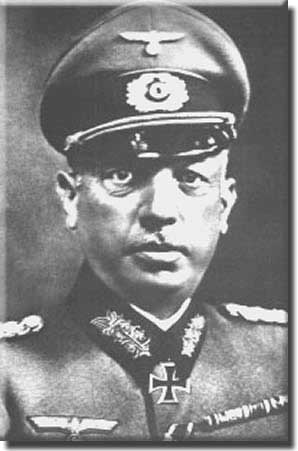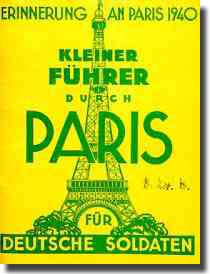|
Field Marshal Georg von Kuechler. ( 1881- 1969 )
Field Artillery Regiment. At the outbreak of WW1, Kuechler was promoted to Captain and given command of an artillery battery. He spent the war on the Western Front, being in action on the Somme, at Verdun and Champagne. He served as a General Staff Officer with the IV and VIII Corps, and in 1916, was First General Staff Officer ( 1a ) of the 206th. Infantry Division, and later as the 1a of the 8th. Reserve Division in Germany. By 1918 he was on the staff of General Count von der Golz in the Baltic, he remained in that region post WW1, as a member of the Freikorps, in action against both Russians and Poles. Joins the Reichwehr. Infantry Division in East Prussia. A responsible command. When WW2 broke out in September 1939, von Kuechler HQ were renamed 3rd. Army with seven Infantry Divisions, a Panzer Division and four commands of Brigade strength, a formidible force and a most responsible command. Brigade Eberhard was used to take over Danzig, the rest of the command stayed in reserve or screened the Prussian eastern and southern frontiers. Kuechler's forces were successful against the Poles on the Narew and Bug, linking with the Russians who had invaded Poland from the east. In October he was named Commanding General 18th. Army to be back in Germany sitting on the right wing of Army Group B, ready for the Western Campaign. For the May 1940 push against the Allies, Kuechler's job was to overrun Holland quickly, he was given only five divisions of infantry, one motorized division, and a fairly weak 9th. Panzer division, whose tanks were in the main, ones captured in Czechoslovakia. His forces broke through the Dutch frontier on the 10th. of May, it was all over in only four days with the Dutch surrendering on the 14th. of May. He now turned south, took Antwerp, and moved onto Dunkirk capturing 40,000 French soldiers that the Royal Navy had not been able to lift off the beach in time. Now the 18th. Army had the task of taking Paris, but it was declared an Open City on the 13th. of June, and the next morning the General's 218th. Infantry Division marched down the famous Champs - Elysses in parade order, a highlight in the military career of Kuechler to date. Promoted.
Back to Poland and the invasion of Russia. With the Russian winter offensive in full cry, von Leeb requested he be relieved of his command, and Hitler gave this command to Georg von Kuechler. Army Group North consisted of Lindemann's 18th. Army, and Busch's 16th. Army. The former held the southern approaches to Leningrad, and the latter, occupied a thin line from Lake Ilmen to Ostashkov. The tough Russian Winter. Against the strong assaults of Russian forces, the German Armies were not strong enough to hold a continous line, so they tried to hang on to strategic major crossroads. The 281st. Division and all of II Corps, a force of 100,000 were encircled at Kholm and at Demyansk, they had to be supplied via the Luftwaffe, but the Germans managed to hold on. By early in March, Kuechler had the situation in hand, on the 15th. he sent Lieutenant General Altrichter's 58th. Infantry Division off to attack the southern base of the Russian penetration of his line, and the 4th. SS Motorized Division to go after their northern base. The two Divisions were able to join up four days later to catch the two Soviet forces. Seventeen Russian Divisions were wiped out, and only 32,000 of their troops surrendered. But at Kholm, Theodor Scherer's garrison of 5,000 was under threat from the Soviet 3rd. Strike Army, survivors were finally rescued by the 122nd. Infantry Division, after a 103 day siege, but only 1,200 effective troops and 2,200 wounded greeted their rescuers. By the 2nd. of May, land delivered supplies finally reached Demyansk. Promotion to Field Marshal. Manstein's 11th. Army was moved from the Crimean area to the north with a view of again attacking Leningrad, but the Russians got in first, attacked, pinning down Manstein in defensive fighting, now Stalingrad was surrounded, and as Manstein's troops were sent off to the south, an offensive against Leningrad was not possible. The Soviets tried to break the siege of Leningrad but the Germans hung on repulsing all their attempts. The Russians now built up their forces for yet another offensive, using 12 divisions they attacked at Schluesselburg on the 12th. of January 1943, and within a week had built up a six mile corridor into Leningrad, the first time that city had a link to the world outside in 17 months. The Russians kept up their attacks until April in 1943, but made little further gains. Army Group North. In autumn of 1943, Stalin committed another army to the Northern front and Kuechler believed that he was about to face yet another offensive, and he asked for another six divisions but Hitler had over extended himself and was unable to accede to this request, but he now added the Nevel sector to Kuechler's responsibilities, it was formerly on the northern arm of Army Group Centre. This gave Kuechler an extra 48 miles of front, and three more divisions. Soviets attack left flank of Kluge's Army Group Centre. Hitler was furious at this loss, Kluge wanted to prop up the Luftwaffe Field division by merging it with an Army division, but Hitler said no. Kluge was now injured in a car accident, and had to be replaced by Field Marshal Busch. Although Hitler wanted Nevel retaken, this was never achieved, and he blamed the loss on " petty egotism" between the Army Group Commanders, perhaps this had a ring of truth to it, Kuechler and Busch never worked well together, just after Kuechler had taken over command of Army Group North, he tried to get rid of Busch, but his request was denied at the time. By the end of 1943, Army Group North was down to forty divisions, guarding 500 miles of front, and not a panzer division, or even a panzer brigade in their total zone of responsibility. Kuechler wanted to withdraw a 100 miles to the west to cut back his front to 440 miles, but Hitler said no! Now he lost three more divisions to Army Group South, his protests to no avail. Early in 1944, the Russians attacked at Leningrad in an attempt to crack the German hold over that city, Colonel General Georg Lindemann's 18th. Army was in trouble, by the 17th. of January he was forced to commit all of his reserves, he wanted to retreat, a word that Hitler simply hated, and as usual said NO. Two German divisions were on the verge of annihilation, and Kuechler told Berlin he was going to retreat whether Hitler approved or not, he at last relented, but it was to be limited and not a general retreat. The retreat order was too late to save the two Divisions between Leningrad and Oranienbaum, they were both trapped and destroyed between the Soviet 2nd. Shock troops and the 42nd. Armies. Lindemann's southern flank was separated from the 16th. Army, and if the 18th. Army was not allowed to pull back it would face encirlement. On the 27th. of January 1944 Kuechler attended a National Socialist Leadership Conference at Koenigsberg, ( it seems an odd time for the Field Marshal to absent himself from his front ) and he told Hitler that already the 18th. Army had suffered 40,000 casualities and was fighting with great vigour, but it must be allowed to retreat behind the Luga. Hitler told his commander that he alone had the right to order a withdrawal. It would seem that Kuehler's effectiveness as a field commander was destroyed at that meeting with Hitler. The Field Marshal's Chief of Staff, Lieutenant General Eberhard Kinzel gave the verbal order for the 18th. Army to retreat, acting as if his boss had given the order himself. Hitler finally at the end of January approved that order, but insisted that the Luga line be maintained, earlier that may have been practicable, but it was now too late, the 18th. Army was fragmented into three bits, its strength reduced from 58,000 to only 17,000. Kuechler was to be made to pay for the debacle, he was summoned to the Fuehrer's HQ, and on the 31st. of January relieved of his command to be replaced in the short term by Walter Model. He now disappeared from the scene, but was approached to join the anti-Hitler clique, but refused. Although described as thoroughly Prussian, he did display compassion to enemy civilians in both Poland and Russia. But came down like a ton of bricks on any guerrillas caught. At the end of WW2 he was placed on trial at Nurenberg as a minor war criminal, and on the 28th. of October 1948, drew a 20 year sentence for his " cold blooded and ruthless" treatment of Russian partisans, perhaps a severe punishment, but he was freed after 7 years in 1955. Living in retirement in the Garmish-Patenkirchen district, he died in 1969. Conclusion. Unlike some of his contemporaries, he did stand up to Hitler for the lives of his troops when retreat was the only option. He faded from the scene both before and after his trial and imprisonment.
See the Index to "Adolf Hitler and his WW2 Field Marshals" |

 Georg von Kuechler was born on the 30th. of May, 1881 into an old Prussian Junker family at Schloss Philippsruh. As one would expect he was educated at Cadet Schools so he might enter the Imperial Army, which he did on the 12th. of March in 1900 as an artillery Fahnenjunker in the 25th.
Georg von Kuechler was born on the 30th. of May, 1881 into an old Prussian Junker family at Schloss Philippsruh. As one would expect he was educated at Cadet Schools so he might enter the Imperial Army, which he did on the 12th. of March in 1900 as an artillery Fahnenjunker in the 25th.